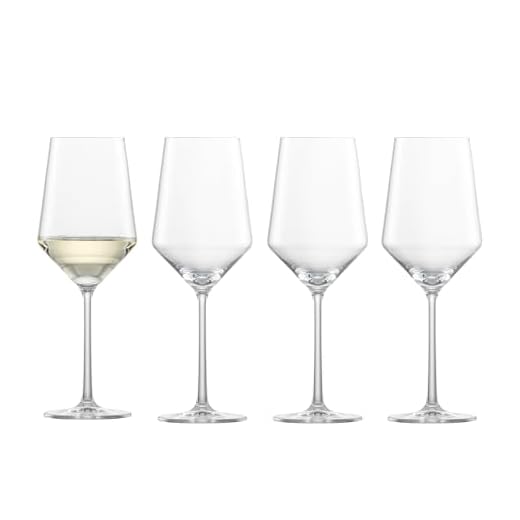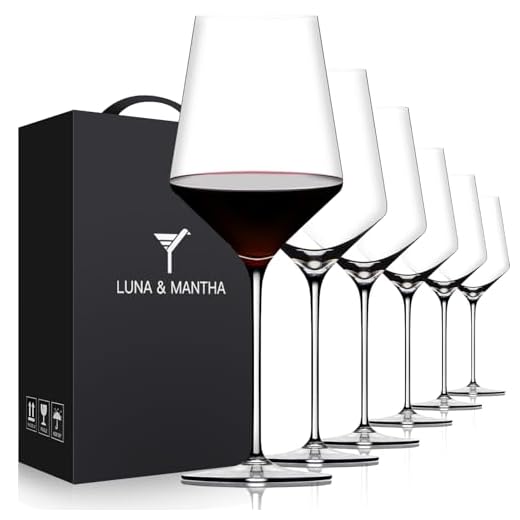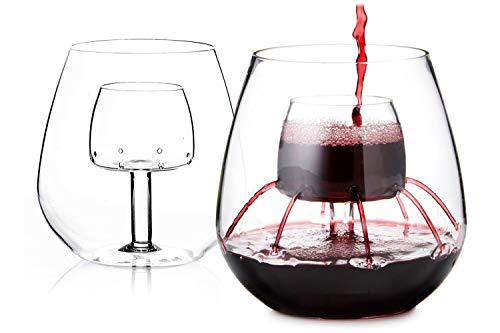



Choosing the right vessel can elevate your experience with fermented grape juice significantly. For robust varieties, opt for larger bowls that allow aromas to develop, enhancing complexity. A narrower rim helps concentrate scents, which is particularly beneficial for bolder options. In contrast, a more slender design suits lighter selections, promoting freshness and crispness, allowing delicate notes to shine.
Consider the stem length as well. Longer stems facilitate holding without warming the liquid, maintaining its ideal temperature. This is especially crucial for lighter styles that thrive on coolness. Meanwhile, shorter stems can provide a more casual feel for heavier varieties, where warmth can benefit the overall tasting profile.
Material also plays a role in the sensory experience. Crystal enhances clarity and brilliance, allowing for a more immersive visual experience. Thinner glass can enhance the tactile sensation, making each sip more pleasurable. Selecting the appropriate type can significantly influence not just the taste but also the enjoyment of your beverage.
Design Features of Red Wine Glasses
For optimal enjoyment of bold varietals, choose vessels with specific characteristics. These attributes enhance aroma, taste, and overall experience.
- Bowl Shape: A wider bowl allows for better aeration, facilitating the release of complex aromas. This design promotes swirling, which enhances interaction with oxygen.
- Rim Diameter: A slightly flared rim helps direct the flow of liquid to the palate, accentuating the wine’s richness and tannins.
- Height: Taller designs maintain temperature and contribute to a more concentrated bouquet. The height also creates a more elegant presentation.
- Glass Thickness: Thinner glass provides a more refined touch, allowing for an unobtrusive drinking experience, highlighting the wine’s texture.
- Stem Length: A longer stem prevents heat transfer from hands, ensuring a cooler serving temperature, which is particularly important for fuller-bodied wines.
When selecting a glass for robust selections, consider these aspects to enhance the tasting experience. Pairing the right vessel with the right varietal can reveal layers of flavor that might otherwise go unnoticed.
Design features of white wine glasses
Choosing a glass for lighter varietals is crucial to enhance aromatic qualities. A narrower bowl helps concentrate delicate scents, allowing for a more focused olfactory experience. The rim is typically thinner, promoting a seamless flow of liquid, which encourages a crisp sensation on the palate.
The stem length is generally longer, providing a comfortable grip while minimizing warmth transfer from the hand. This is vital for maintaining the refreshing temperature that characterizes these beverages. Additionally, the base is often wider to allow for adequate aeration, ensuring that the subtle nuances of flavor are fully expressed.
When serving chilled selections, consider the glass’s capacity. Most have a modest size, which helps preserve the cool temperature longer. For optimal enjoyment, select a vessel that complements the specific varietal you’re savoring. A well-designed glass can significantly enhance the tasting experience, making it essential for any enthusiast.
For a delightful pairing experience, try serving a savory dish alongside your favorite white. If you’re interested in elevating your culinary skills, check out this guide on how to cook fillet steak in a cast iron skillet. It can be a fantastic complement to your chilled selection, creating a memorable meal.
Impact of Glass Shape on Wine Aroma
Choosing the right vessel significantly enhances aromatic expression. For optimal results, select a glass that complements the characteristics of the beverage within. A broader bowl encourages volatile compounds to disperse, intensifying the bouquet, while a narrower opening retains those aromas longer.
For full-bodied varieties, a glass with a wider rim promotes airflow, allowing the drinker to appreciate complex notes. In contrast, smaller openings are better suited for lighter styles, concentrating delicate fragrances.
Consider the following attributes when selecting a vessel:
| Feature | Effect on Aroma |
|---|---|
| Shape | Influences how aromas are directed to the nose. |
| Bowl Size | Affects the release of volatile compounds; larger bowls enhance complexity. |
| Rim Diameter | Narrow rims limit airflow; wider rims promote aromatic exploration. |
When serving, gently swirl the liquid within the glass to release additional aromas. This action can reveal hidden layers, enhancing the overall tasting experience. Remember, the right vessel does not merely hold the liquid; it plays a crucial role in elevating the sensory journey.
Temperature Insights for Varietals
Serving temperatures significantly impact the enjoyment of different varietals. For optimal experience, light-bodied options should be chilled to around 45-50°F (7-10°C). This temperature enhances their refreshing qualities, allowing crisp acidity to shine.
Full-bodied offerings, on the other hand, thrive at temperatures between 55-65°F (13-18°C). Slight warming helps release complex aromas and flavors that might otherwise remain muted. Keeping these varieties too cold can mask their richness.
When serving, consider the environment. A warm room can raise temperatures quickly, so it’s wise to have a plan for maintaining ideal conditions. Utilizing ice buckets or wine coolers can help, particularly for lighter selections, while allowing fuller varieties to breathe at room temperature can elevate the tasting experience.
Keep in mind that personal preference plays a role. Experimentation with different temperatures can lead to discovering unique flavor profiles that resonate with individual palates.
Choosing the Right Glass for Specific Wine Types
For optimal enjoyment, select a vessel that complements the characteristics of your beverage. For instance, fuller-bodied varieties, such as Cabernet Sauvignon, benefit from a glass with a larger bowl, allowing for better aeration and aroma release. Conversely, lighter selections like Pinot Grigio thrive in narrower options to preserve their delicate notes.
Consider the alcohol content as well. Higher alcohol content wines, including Zinfandel, are best served in glasses that provide ample space for swirling, enhancing their complexity. Lighter options, like Sauvignon Blanc, can be appreciated in streamlined designs that maintain their crispness.
Another aspect to keep in mind is the aging factor. Matured selections, which often possess more intricate flavors, should be served in wider vessels to facilitate oxidation, while young varietals can shine in more compact shapes that encourage freshness.
Finally, don’t overlook the occasion. Formal settings often call for elegant designs, while casual gatherings may be suited for more robust options. Tailoring your choice to the specific type enhances the overall experience and appreciation of the beverage.
Cleaning and Maintenance of Wine Glasses
Hand wash using warm water and mild detergent. Avoid abrasive sponges that can scratch surfaces. Rinse thoroughly to eliminate any soap residue, which can affect taste.
For stubborn stains, soak in a mixture of water and white vinegar for a few minutes before scrubbing gently. This method effectively removes discoloration without damaging the material.
Dry with a lint-free cloth or allow to air dry upside down on a clean surface. Ensure no moisture remains, as it can lead to spots or streaks.
Store upright in a dust-free environment. If stacking is necessary, place a soft cloth between each piece to prevent chipping. Keep away from direct sunlight to avoid fading or warping.
Regularly inspect each piece for cracks or chips. Damaged items should be replaced promptly to maintain an enjoyable tasting experience.
For those who use a dishwasher, select a gentle cycle and avoid high heat settings. Use a secure rack to prevent movement during the wash, which may cause collisions and damage.







